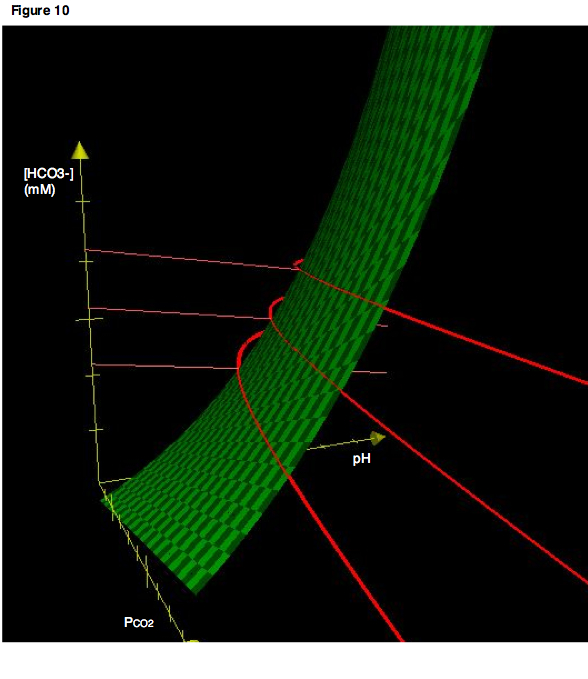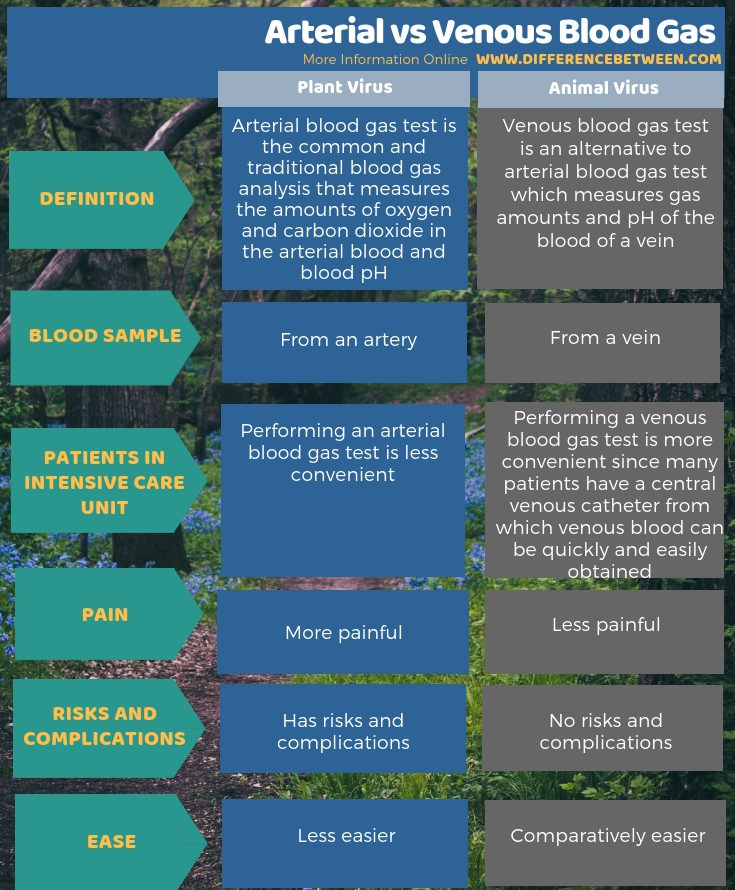The key difference between arterial and venous blood gas is that arterial blood gas test uses a small blood sample drawn from an artery while venous blood gas test is a comparatively less painful test that uses a small blood sample drawn from a vein.
Blood is a body fluid that delivers vital substances such as nutrients, oxygen and ions, etc., into our cells and tissues. Blood also transports metabolic waste and carbon dioxide away from the cells and tissue. Moreover, blood circulates via blood vessels; arteries and veins mainly. Maintaining proper levels of oxygen, carbon dioxide and pH in blood is critical in order to prevent lung diseases, to detect an acid-base imbalance in our body, etc. Blood gas test is a test that measures blood pH and levels of oxygen and carbon dioxide. Furthermore, there are two blood gas tests: arterial blood gas test and venous blood gas test.
CONTENTS
1. Overview and Key Difference
2. What is Arterial Blood Gas
3. What is Venous Blood Gas
4. Similarities Between Arterial and Venous Blood Gas
5. Side by Side Comparison – Arterial vs Venous Blood Gas in Tabular Form
6. Summary
What is Arterial Blood Gas?
Arterial blood gas test is the common test of blood gas analysis. This test analyzes a small blood sample taken from an artery, especially from a radial artery. A blood sample can be drawn by using an aseptic needle. After drawing the blood sample, it is necessary to analyze it within 10 minutes to obtain accurate results. This procedure is very safe, simple and very quick.

Figure 01: Arterial Blood Gas Test
Arterial blood gas test evaluates different parameters such as partial pressure of oxygen and carbon dioxide, arterial blood pH, bicarbonate level and oxygen saturation, etc. By measuring those parameters, several diseases such as lung diseases, kidney diseases, respiratory problems, heart failures, etc. can be diagnosed.
What is Venous Blood Gas?
Venous blood gas test is an alternative test of blood gas analysis. It requires drawing of a small blood sample of a vein. Drawing a blood sample from a vein is less painful compared to drawing a blood sample from an artery. Hence, the venous blood gas test is less painful than the arterial blood gas test.

Figure 02: Drawing a Blood Sample
Furthermore, the venous blood sample is analyzed using the same arterial blood gas analyser. It measures the gas levels of the venous blood. Moreover, it measures the pH of venous blood. In comparison to arterial blood gas, venous blood gas test poses low risks and complications to the patient.
What are the Similarities Between Arterial and Venous Blood Gas?
- Arterial blood gas test and venous blood gas test are two types of blood gas analysis.
- They measure gas levels and blood pH.
- These tests are helpful in order to check whether a person has respiratory problems, lung diseases, kidney diseases, acid-base imbalance, etc.
- In both tests, a blood sample is drawn for the analysis.
- However, both tests do not require a large sample of blood.
- Both tests are safe, simple and quick.
- Moreover, both tests utilize a piece of equipment called arterial blood gas analyser.
What is the Difference Between Arterial and Venous Blood Gas?
Arterial blood gas test requires a small blood sample of an artery while venous blood gas test requires a small blood sample from a vein. Thus, this is the key difference between arterial and venous blood gas. Furthermore, venous blood gas test is less painful than arterial blood gas test. This is also a difference between arterial and venous blood gas. Not only that, venous blood gas test is patient-friendly and easier than arterial blood gas test.

Summary – Arterial vs Venous Blood Gas
Blood gases are oxygen and carbon dioxide. Therefore, a blood gas test evaluates the amounts of oxygen and carbon dioxide in the blood and the efficiency of our lungs in moving oxygen into the blood and carbon dioxide from the blood. Arterial blood gas test measures the levels of arterial oxygen and carbon dioxide while venous blood gas measures the levels of oxygen and carbon dioxide in the vein. Both tests are safe and fast. This summarizes the difference between arterial and venous blood gas.
Reference:
1. Nall, Rachel. “Blood Gas Test.” Healthline, Healthline Media, 1 July 2019, Available here.
2. “Arterial Blood Gas Test.” Wikipedia, Wikimedia Foundation, 27 May 2019, Available here.
Image Courtesy:
1. “Davenport fig 10” By User:Thewookie55 – Own work (Public Domain) via Commons Wikimedia
2. “blood draw” Robert Couse-Baker (CC BY 2.0) via Flickr
ncG1vNJzZmivp6x7pbXFn5yrnZ6YsqOx07CcnqZemLyue8OinZ%2Bdopq7pLGMm5ytr5Wau26t0a2cq6GRoXqiusNmrZ6mn6rAbq7LqKadZZeWwHA%3D